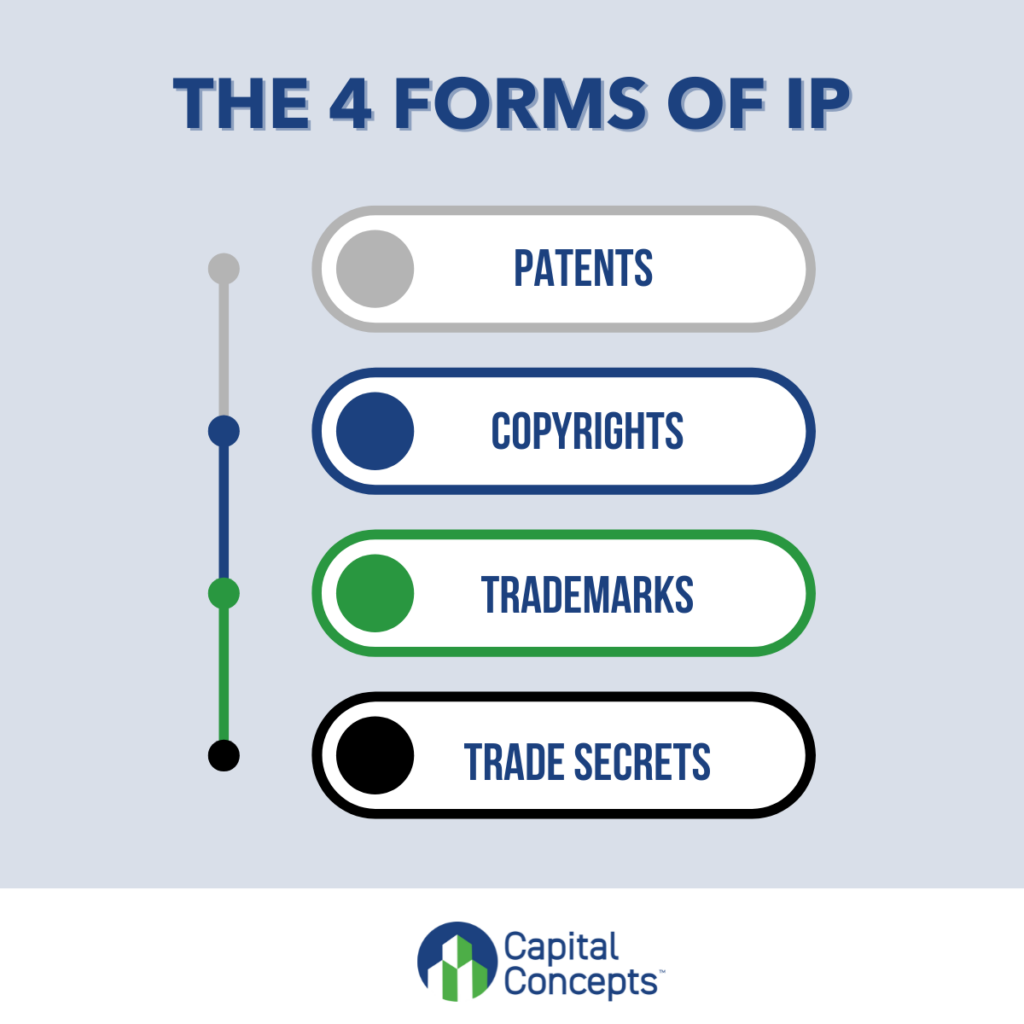Intellectual property (IP) is a highly valuable type of intangible capital or asset. It can take one of four forms: trademarks, patents, copyrights, and trade secrets. Your company must take the time to understand intellectual property and business value , investing the resources to protect its IP. This type of asset can be one of the most valuable to your business. (We cover other types of assets that build business value in this article.)
According to the Dennemeyer Group,
Intellectual Property (IP) assets are among the most valuable possessions of any organization. For many, these intangible properties are worth more than their tangible assets, including cash, liquid financial holdings, buildings, equipment and land. Indeed, for most S&P 500 companies, tangibles comprise just 16% of their value, while intangibles such as IP rights and even more abstract resources like reputation constitute the remaining 84%.
Security for your IP must be a high priority. The way you protect each of the four types varies, as follows. (Always consult with an attorney to understand the particulars for your situation.)

Patents
Patents protect inventions like machines, objects, processes, systems, and even chemical combinations or formulas (such as pharmaceutical products or foods like Coca-Cola). As soon as you’ve created something that’s patentable, file for protection. This will grant you legal ownership over that intellectual property and provide a framework for defending it against infringers. That said, always search existing patents to make sure that the idea hasn’t been patented by someone else. This helps you avoid any potential infringement issues down the line. A patent offers protection for anywhere between 10 and 25 years, depending on the type of invention and jurisdiction where you file the patent.
Once you’ve filed your patents, set up a mechanism for monitoring. This takes time and resources, but it’s worth it to protect your business’s patents; patent infringement is a costly and time-consuming fight! If you find someone else infringing on your patent, taking legal action is the best route to take – hiring an intellectual property lawyer to prepare a lawsuit or file a complaint with the International Trade Commission (if the perpetrator is located overseas). Educate your employees on patent protection because they handle confidential information related to patentable ideas within the company. Train them on company policies for intellectual property protection and non-disclosure obligations.
Copyrights
Copyrights protect original works of authorship – dramatic, literary, and artistic works – for at least 50 years after the author’s death (and up to 70 years in some countries, including the USA). These categories are broad and include traditional works like novels and songs along with software, white papers, and architectural drawings. Registering a copyright with the government protects these works from being reproduced, distributed, or otherwise used without permission. Mark all copyrighted material with the universal copyright symbol, include copyright notices on all digital platforms, and take legal action against any infringers. Remember to educate your employees on copyright protection and develop robust internal policies to protect this intellectual property.
Trademarks
Trademarks (also called service marks) are any words, logos, slogans, symbols, or designs used to identify and distinguish one business’s products and services from those of others in the marketplace. They are often used to enhance brand awareness among consumers while providing protection from any potential infringement or unauthorized use. A recognizable trademark is often a business’s most valuable asset!
To protect trademarks, register them with the Trademark Office of the appropriate jurisdiction. In the USA, you can register trademarks for up to ten years at a time and renew them indefinitely. This helps ensure you have exclusive use of the protected mark and access to legal remedies against infringers. Monitor constantly to make sure that nobody is breaching the territory which the trademark is registered for and take legal action against anyone who attempts to infringe upon it.
Trade Secrets
Trade secrets are confidential business strategies, methods, or formulas that provide a company with a competitive advantage. They can include customer lists, manufacturing processes, marketing plans and algorithms. Protecting your trade secrets is crucial as they are often the key to your success. You must safeguard them from your competitors. Protect your trade secrets by implementing internal policies such as limiting access to specific information, securing documents with passwords, monitoring employee actions on confidential material, and requiring employees and contractors to sign non-disclosure agreements.
Consequences of IP Infringement
When your company lacks clear ownership over your intellectual property (IP) or is involved in an infringement lawsuit, your company could lose control of its own products. Another party could attempt to take ownership of your product or sue for infringements, leading to costly litigation. Any damage awards won by the other party may potentially be passed onto you as the owner, the business, and/or any shareholders you may have. All of this could financially devastate your business and ruin any chance of exiting profitably.
In addition, having unresolved IP issues causes investors to lose trust in the company’s future. Buyers usually require guarantees that there are no potential legal problems associated with the purchase before they agree to go through with the transaction. They are less likely to invest in a business that doesn’t have clear control over its products and technologies because this creates uncertainty about future profits. Current customers might switch providers if faced with conflicting claims from competing companies.
Protecting Your Intellectual Property and Business’s Value
To protect your assets and boost your business’s value, take steps early on to establish clear rights over all intellectual property. Proactively managing IP ownership and resolving any conflicts quickly provides more security for your business, attracts investors who trust you with their products and services, and strengthens your business’s value in the eyes of a prospective buyer.
In addition, you cannot sit back and relax once you’ve established your IP. You must remain vigilant against those who try to infringe on it. And you must continue to innovate. Remember Polaroid, Xerox, Kodak, and Blackberry, all of whom were first to launch their cutting-edge technology and were left behind when they failed to continue pushing the envelope.
This is part of a continuing series on exit planning and building business value. Visit our blog, Insights, to find more articles.
Related Articles
Determining the Value of a Business
How do you determine the value of a business? We discuss four methods for determining value, along with the variables and complexities that valuation professionals must factor in. You can address some of these factors ahead of time to set yourself up for the best result.
The Formula for an Effective Exit Plan
Ask a business owner over the age of 50 when they plan to transition or exit their business, and you’ll get one of two answers:
– a blank stare, or
– “I’ll work another 5-10 years and call it quits.”(And if you ask this person again in another 5-10 years, you’ll likely get the same answer!)
The bottom line is the same – most business owners lack a plan for leaving their business. Read the article to learn what goes into an exit plan.
The Benefits of Planning for Life Outside of Work
How long has it been since you did something just for the fun of it? What is on your list of “Things I’ll Do Someday When I Have Time”? You may think that you need to wait to start checking things off that list, but that’s a mistake.
There’s more to life than work, and it’s the things you enjoy in your leisure time that make you a well-rounded and happy human being. In this article, we invite you to start exploring and experimenting to find enjoyable and fulfilling activities outside of work and give some practical suggestions for how to do it.

